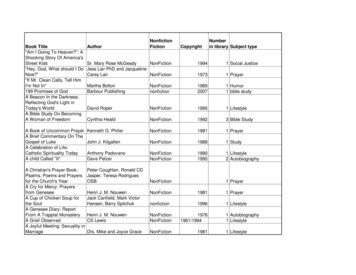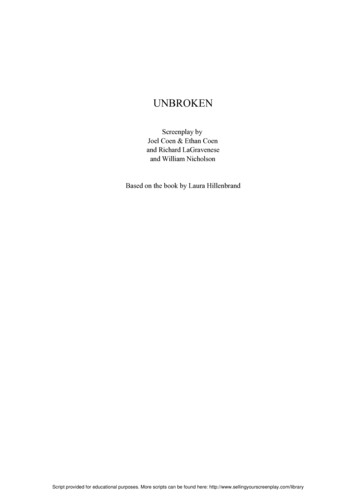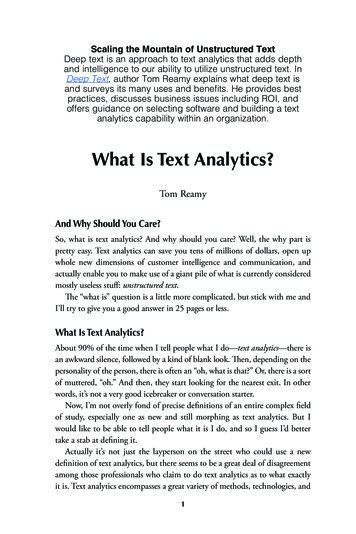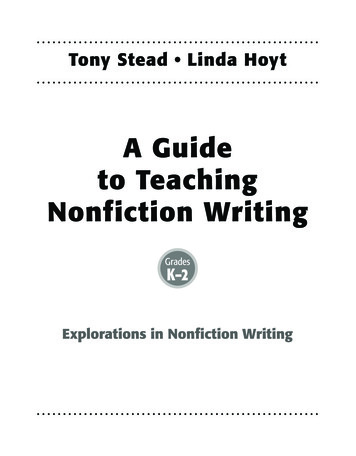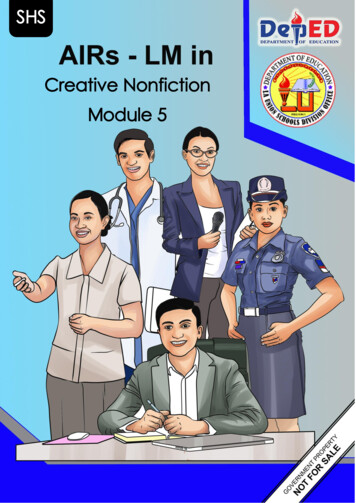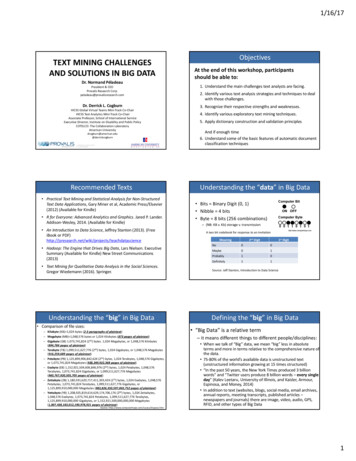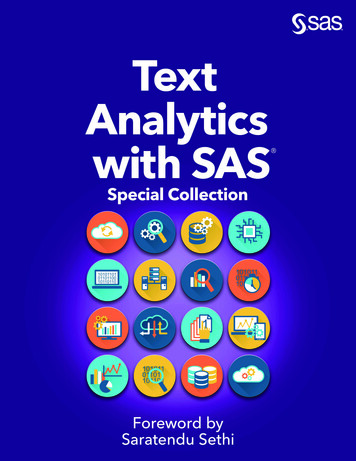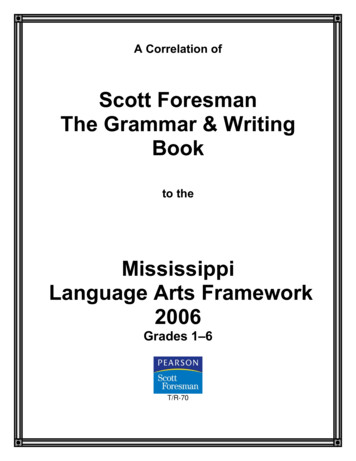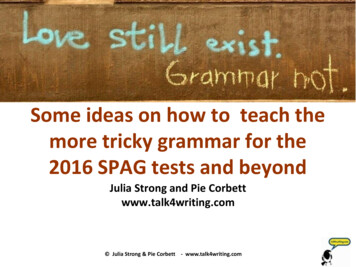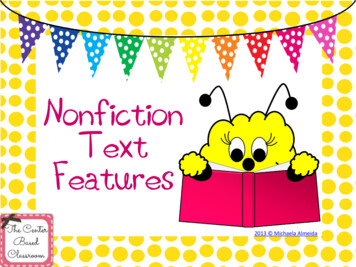
Transcription
NonfictionTextFeatures2013 Michaela Almeida
Teacher InfoThis product includes 11 posters about nonfiction textfeatures. Each poster shows an example of the textfeature and explains how each text feature helps readersto understand.Also Included (Info on pages 3 and 4):My Text Feature BookText Feature Scavenger Hunt2013 Michaela Almeida
Teacher InfoText Feature Scavenger HuntThis can be done individually or in pairs. Givestudents a copy of the scavenger hunt paper. Theyshould choose a nonfiction book to read. While theyare reading, they are looking for text features intheir books. When they find one, they should recordit on the paper and explain how it helped them tounderstand the book.2013 Michaela Almeida
Teacher InfoMy Text Feature BookEach student creates their own nonfiction textfeature book. They are given the blank graphicorganizers with the type of text feature filled in.Using kid friendly magazines and newspapers (oranother nonfiction text that can be cut up) theygive an example for each and must write how thattext feature helped them to understand.2013 Michaela Almeida
Photographs & CaptionsA Photograph is a picturethat shows the readerexactly what something lookslike.Captions are the words nextto or underneath aphotograph that tell you whatit is or what it is about.The Bald Eagle is the NationalBird of the United States.2013 Michaela Almeida
KeywordsItalic Print identifies new andimportant detailsPronunciation Guides showthe reader how to say adifficult word.Bold Print brings attentionto important words thatcan usually be found in theglossary.Why are the South’swetlands so important?The Okefenokee (oh kuhfuh NOH kee) Swamp is awetland in the South. Awetland is a place wherethe ground is soaked withwater for at least part ofthe year.2013 Michaela Almeida
HeadingsHeadings let thereader know whatthe section will beabout. It is usuallywritten in larger,bold print.What is a Forest?A forest is a natural areawhere many trees grow.Forests are not just made upof trees, however. Theyinclude smaller plants, suchas shrubs, mosses, andferns. Some forests surroundlakes, and some have riversor streams running throughthem.2013 Michaela Almeida
SubheadingsSubheadings helpreaders “chunk”the text intosmaller partsthat arerelated to theheading.What is a Forest?A forest is a natural area where manytrees grow. Forests are not just made upof trees, however. They include smallerplants, such as shrubs, mosses, andferns. Some forests surround lakes, andsome have rivers or streams runningthrough them.Types of TreesThere are two man types of trees:Conifers and Broadleafs. Conifers, suchas pine trees, have cones and needleshaped leaves. Broadleafs, such asmaple trees, have flat, wide leaves.2013 Michaela Almeida
MapsA map shows thelocation of thingsor places.2013 Michaela Almeida
Table of ContentsThe table of contentsis found at thebeginning of a book. Ithas chapter titles andheadings to let thereader know whatpage they can findthem on.Chapter 1: All About AnimalsAdaptations Page 1Food . Page 2Habitats Page 3Homes . Page 4Chapter 2: All About PlantsPhotosynthesis .Page 5Types of Plants Page 62013 Michaela Almeida
GlossaryA glossary is similarto a dictionary. Itlists vocabularywords from thebook in alphabeticalorder and tells theirdefinitions.PPaleontologist: A scientistwho studies the history oflife on Earth.Prehistoric: Before history.Primates: group of animalsthat includes monkeys,apes, humans, and lemurs.2013 Michaela Almeida
IndexThe index is found at theback of the book. It listsimportant topics inalphabetical order andshows what page theycan be found on. Theindex helps a reader tolocate informationquickly.AAnimal Adaptations pages11, 18Animal Food page 10Animal Habitats pages 20-27Animal Homes page 52013 Michaela Almeida
Diagrams & LabelsA diagram is a picture orillustration that show theparts of something.Labels are near diagramsor photographs. They areusually one or two wordsand point to the differentparts of something.2013 Michaela Almeida
TimelinesA timeline tellsimportant eventsthat happened inorder. Timelinescan be about aperson’s life orevents in history.2013 Michaela Almeida
Charts & GraphsFavorite Colors of StudentsNumber of StudentsCharts andgraphs showinformation in avisual way so thereader cancompareinformationColors2013 Michaela Almeida
Name:Title:Nonfiction Text Feature Scavenger HuntText FeaturePhotographs andCaptionsKeywordsHeadingsSubheadingsMapsPage #How did they help you understand?
Text FeatureTable ofContentsGlossaryIndexDiagrams andLabelsTimelinesCharts andGraphsPage #How did they help you understand?
MyTextFeaturesBookCreated By:2013 Michaela Almeida
Photographs & CaptionsHow Do They Help Us Understand?Example:2013 Michaela Almeida
KeywordsHow Do They Help Us Understand?Example:2013 Michaela Almeida
HeadingsHow Do They Help Us Understand?Example:2013 Michaela Almeida
SubheadingsHow Do They Help Us Understand?Example:2013 Michaela Almeida
MapsHow Do They Help Us Understand?Example:2013 Michaela Almeida
Table of ContentsHow Does it Help Us Understand?Example:2013 Michaela Almeida
GlossaryHow Does it Help Us Understand?Example:2013 Michaela Almeida
IndexHow Do They Help Us Understand?Example:2013 Michaela Almeida
Diagram & LabelsHow Do They Help Us Understand?Example:2013 Michaela Almeida
TimelinesHow Do They Help Us Understand?Example:2013 Michaela Almeida
Charts & GraphsHow Do They Help Us Understand?Example:2013 Michaela Almeida
Thank you for downloading my product!For more activities, please MichaelaAlmeidaTpT users, please leave some feedback for credits!Every 100 credits is worth 5 dollars towards future TpT purchases!Other places to find the CenterBased Classroom:The Center Based Classroom BlogFacebook - The Center Based ClassroomTwitter - The Center Based ClassroomSpecial Thanks:Clip Art lhttp://catladygraphics.blogger.com & http://frompond.blogspot.com
This can be done individually or in pairs. Give students a copy of the scavenger hunt paper. They should choose a nonfiction book to read. While they are reading, they are looking for text features in their books. When they find one, they should record it on the pap
